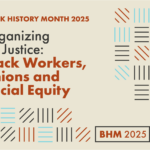One in three workers have experienced domestic violence, and for many, the violence follows them to work.
Often abusers will try to prevent their partners or ex-partners from getting to work, causing them to be late or have to miss work. Abusers may also excessively call, email, or text victims while they are at work, come into the workplace, or stalk the victim.
“[The abuser] would phone my workplace to see what time I had left, and phoned when I arrived to make sure I was actually going to work.”
Over 80 percent of people who experience domestic violence report that their work performance was negatively affected. Absenteeism and poor work performance can leave survivors vulnerable to discipline, and some even lose their jobs.
“Dealing with my ex-husband left me feeling anxious, tired due to lack of sleep. It affected the pleasure my work usually gives me.”
Work can be a safe haven for someone who is experiencing violence at home. The financial security of a job and some time away from their abuser can help a person experiencing violence seek support or make a plan to leave the relationship. However, the workplace can also be a dangerous place for people experiencing domestic violence, since abusers know where to find them.
Abusers also feel the impacts of their behaviour at the workplace. They may use work time or equipment to send abusive messages or otherwise plan and carry out violent acts. They may be preoccupied or distracted, affecting their work performance and leaving them vulnerable to discipline or job loss—which then puts the person targeted by their abuse at greater risk, as unemployment is a risk factor for serious injury or death.
Co-workers and others in the workplace can also experience the negative effects of domestic violence through increased workloads, stress, calls or visits from their co-worker’s abuser, and other potential safety risks.
“My co-workers were worried and disturbed by the physical and emotional evidence of the abuse.”
Why is domestic violence a union issue?
Unions must ensure that work is safe for everyone. Unions protect the rights of all workers, and if one worker is vulnerable, all workers are affected.
The CLC’s National Survey on Domestic Violence at Work showed that significant numbers of union members experience domestic violence and that violence at home can put all workers at risk.
What are unions doing about domestic violence?
Unions build awareness about domestic violence and its impacts at work, and they work to support members and ensure employers live up to their obligations.
Unions build connection and a sense of belonging among their membership. This means unions play an important role in breaking the barriers of silence and isolation that, too often, come with domestic violence. Unions also help rank-and-file members and workplace representatives alike learn how to recognize the warning signs and risk factors of domestic violence at work and understand what supports are available. This helps put an end to the idea that domestic violence is strictly a private matter, and helps increase workplace safety.
“[I] lied about injury and absence due to fear and not able to admit to abuse at that time.”
Unions also act as a bridge for people experiencing domestic violence for reaching support. They also make sure that employers follow violence legislation, support workers who are targeted by abuse in making a safety plan, and help people experiencing abuse approach management with specific workplace accommodations such as time off.
Bargaining contract language to address domestic violence
Many collective agreements contain clear language about workplace violence. Today, unions are working to add new language that addresses domestic violence as a workplace issue.
This new language includes supports like:
- Workplace safety planning
- Paid domestic violence leave
- Protection from discrimination or adverse action, and
- Access to a women’s advocate or other designated support person within the workplace.
It can be challenging for members to speak up when they see warning signs of domestic violence at work. This is why it’s vital that unions take the initiative to address domestic violence at work by building awareness and making it a bargaining priority. This is how unions send a message to the members that they can trust their union, and that help is at hand.
Learn more about language for collective agreements that unions can adapt in their own negotiations.
Who is most at risk?
Domestic violence happens in all cultures and religions, in all ethnic and racial communities, at every age, and in every income group. However, some groups are more vulnerable to serious injury or death.
All domestic violence is harmful. However, when an abuser habitually controls and coerces their partner, the risk to the victim is greater. For more information on high risk domestic violence, please click here.
Although people of all genders experience domestic violence, victims of high-risk cases with the most serious injuries are women.
It’s crucial – for unions and employers alike – to recognize that different women face different levels of risk and may endure extra barriers to support and healing. This is why unions take special care to advocate for women with disabilities, women of colour, young women, Indigenous women, LGBTQ2SI women, immigrant women and women in rural communities who may face different kinds of barriers.
What are some warning signs of domestic violence at work?
All workers should be able to recognize the signs of abuse. Some of the warning signs that a co-worker might be experiencing abusive behaviour include when they:
- Have obvious injuries such as bruises, sudden hearing loss, cuts or broken bones
- Wear clothing inappropriate for the season (such as a turtleneck in summer) or often wear sunglasses indoors or heavy makeup
- Suddenly are more absent or late for work or work extra hours to be away from home
- Change their job performance such as having trouble concentrating at work or making frequent errors
- Are showing uncharacteristic signs of anxiety, fear, isolation, and/or depression
- Ask for special accommodations such as to leave work early
- Are sensitive about home life or hints about trouble at home, or
- Express fear of losing their job
Just because a worker possesses some of these traits does not necessarily mean they are experiencing domestic violence.
Please visit the Make It Our Business page for more information on warning signs of domestic violence at work.
Note: Never jump to conclusions when observing what may appear to be warning signs for domestic violence. Ask questions instead, and always stick to the facts when approaching someone you suspect may be experiencing domestic violence.
I am worried about a co-worker. What can I do?
- Recognize the warning signs. A good starting point to understand domestic violence at work is to recognize the warning signs of abusive behaviour and to recognize when a situation is high risk.
- Break the stigma. It’s important to remember that isolation is always present in an abusive relationship. To combat isolation, co-workers must move beyond the idea of “minding their own business” and break the stigma around domestic violence.
- Talk to them. To interrupt isolation, approach the worker at an appropriate time and place. Let them know you’re worried about them. Stick to the facts, such as letting them know you’ve noticed out of character behaviour. For example, you might say “I’ve overheard your partner yelling at you on the phone…”
-
- Your goal is to open up the door for support. To accomplish this, make sure your co-worker does not feel that you are passing judgment or trying to fix the situation.
- Keep it human. Continue the conversation by asking them questions like, “Are you OK?” or “Do you want to talk?”
- Show them that support is available. The next best step after expressing concern is to refer your co-worker to a domestic violence support network. This may be community-based or a designated person in the workplace such as a union steward, a human resources official, a women’s advocate, or a health and safety representative. For information on domestic violence resources, please click here.
Note: It’s possible the co-worker may deny they are being abused. If you remain concerned, continue to reassure them they can talk any time, remain compassionate, and consider having an informal conversation with a trusted, designated person in the workplace.
What are some simple dos and don’ts when addressing domestic violence at work?
- Do patiently listen to what the survivor shares with you.
- Don’t judge, criticize, or gossip about the situation. Whether you have a suspicion that a co-worker is experiencing domestic violence or they’ve disclosed information to you, keep the information between you, the person experiencing abuse, and the designated workplace representative.
- Do assure the person experiencing domestic violence that you believe what they are saying and that they are never to be blamed.
- Don’t promise the worker you will keep a secret no matter what. If you have clear evidence that someone in the workplace is experiencing domestic violence or that their safety is at risk, you have an obligation to report it to an “expert” either in or outside of the workplace.
- Do tell the worker that there are people and resources at work that can help.
- Don’t allow warning signs or a disclosure to go unaddressed—assure the victim that you want to help. Follow up to ensure that they have been given supportive resources.
Click here for more “Dos” and “Don’ts”
What if I think someone is seriously at risk?
If you think someone is in immediate danger, call 911.
If possible, discuss calling the police with the person experiencing domestic violence beforehand. When there is a threat of immediate danger, this might not be possible.
Ask yourself:
- Is the risk of physical violence immediate? For example, the abuser is on their way to the victim’s location with the intention to harm. Or, you witness or hear an abuser assaulting a victim or issuing threats to harm or kill.
- Does the abuser have immediate access to firearms or other weapons?
If the answer to either of the above is yes, you need to call the police.
What to consider before calling the police:
Members of some communities have more complex relationship with the police. It is useful to consider:
- Is the victim a Canadian citizen? If the person is an immigrant or refugee, then involving authorities might put them at risk of deportation.
- Who has custody of the children? Has the person experiencing domestic violence recently regained custody or visitation with her children? If the victim is vulnerable, then she might be at risk of having her children apprehended.
- Could calling the police out the person experiencing domestic violence as LGBTQ2SI? If they are trans or in a same-gender relationship, they could be outed in the community and/or the police might respond to them differently.
- How else could the victim be affected by police intervention? Even someone experiencing domestic violence can be charged with a crime if police become aware of it during a domestic disturbance call.
- What can be done to ensure the victim’s safety after the police are called? If an abuser is released shortly after the police visit (or if the police do not arrest or remove the abuser at all), then the person experiencing abuse might be at further risk. Make sure there is a safety plan in place and that the victim has access to shelter space or alternative accommodation if necessary.





